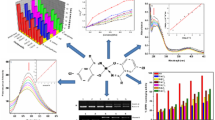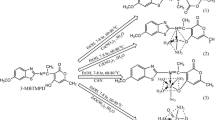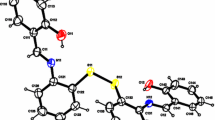Abstract
1-(4-Aminoantipyrine)-3-tosylurea (H2L) and its three lanthanide (III) complexes, M(H2L)3 3NO3 [where M = Nd(III), Sm(III) and Eu(III)], have been synthesized and characterized. In addition, the DNA-binding properties of the three complexes have been investigated by UV–vis (ultraviolet and visible) absorption spectroscopy, fluorescence spectroscopy, circular dichroism (CD) spectroscopy, cyclic voltammetry, and viscosity measurements. Results suggest that the three complexes bind to DNA via a groove binding mode. Furthermore, the antioxidant activity (superoxide and hydroxyl radical) of the metal complexes was determined by using spectrophotometer methods in vitro. These complexes were found to possess potent antioxidant activity and be better than standard antioxidants like vitamin C and mannitol.

Absorption spectra of the complex 3 inTris-HCl buffer upon addition of calf-thymus DNA. [complex]=1×10-5 M, [DNA]=(0-1) ×10-5 M. Arrow shows the absorbance changing upon increasing DNA concentrations. Inset: plots of [DNA]/(εa – εf) versus [DNA] for the titration of DNA with the complex.







Similar content being viewed by others
References
Brown GR, Foubister AJ (1984) Receptor binding sites of hypoglycemic sulfonylureas and related [(acylamino)alkyl]benzoic acids. J Med Chem 27:79–81
Rufer C, Biere H, Ahrens H, Loge O, Schroder E (1974) Blood glucose lowering sulfonamides with asymmetric carbon atoms. 1. J Med Chem 17:708–715
Howbert JJ, Grossman CS, Crowell TA (1990) Novel agents effective against solid tumors: the diarylsulfonylureas. Synthesis, activities, and analysis of quantitative structure–activity relationships. J Med Chem 33:2393–2407
Xu H, Liang Y, Zhang P, Pu F, Zhou BR, Wu J, Liu JH, Liu ZG, Gao L, Ji LN (2005) Biophysical studies of a ruthenium(II) polypyridyl complex binding to DNA and RNA prove that nucleic acid structure has significant effects on binding behaviors. J Biol Inorg Chem 10:529–538
Williams DR (1972) Metals, ligands and cancer. Chem Rev 72:203–213
Grindey GB (1990) Current status of cancer drug development: failure or limited success. Cancer Cells 2:163–171
Zhang SC, Zhu YG, Tu C, Wei HY, Yang Z, Lin LP, Ding J, Zhang JF, Guo ZJ (2004) A novel cytotoxic ternary copper(II) complex of 1,10-phenanthroline and L-threonine with DNA nuclease activity. J Inorg Biochem 98:2099–2106
Mohamadi FB, Spees MM, Grindey GB (1992) Sulfonylureas: a new class of cancer chemotherapeutic agents. J Med Chem 35:3012–3016
Eriksson M, Leijon M, Hiort C, Norden B, Gradsland A (1994) Binding of delta- and lambda-[Ru(phen)3]2+ to [d(CGCGATCGCG)]2 Studied by NMR. Biochemistry 33:5031–5040
Scatchard G (1949) The attractions of proteins for small molecules and ions. Ann NY Acad Sci 51:660–672
Martin RB, Richardson FS (1979) Lanthanides as probes for calcium in biological systems. Q Rev Biophys 12:181–209
Laufer RB (1987) Paramagnetic metal complexes as water proton relaxation agents for NMR imaging: theory and design. Chem Rev 87:901–927
Shibasaki M, Sasai H, Arai T (1997) Asymmetric catalysis with heterobimetallic compounds. Angew Chem Int Ed Engl 36:1236–1256
Xi PX, Liu XH, Lu HL, Zeng ZZ (2007) Synthesis, characterization and DNA-binding studies of 1-(pyridin-2-yl)-3-tosylurea and its Nd(III), Eu(III) complexes. Transit Met Chem 32:757–761
Satyanarayana S, Dabrowiak JC, Chaires JB (1993) Tris(phenanthroline)ruthenium(II) enantiomer interactions with DNA: mode and specificity of binding. Biochemisty 32:2573–2584
Marmur J (1961) A procedure for the isolation of deoxyribonuclei from micro-organisms. J Mol Biol 3:208–218
Pyle AM, Rehmann JP, Meshoyrer R, Kumar CV, Turro NJ, Barton JK (1989) Mixed-ligand complexes of ruthenium(II): factors governing binding to DNA. J Am Chem Soc 111:3051–3058
Michael TC, Marisol R, Allen JB (1989) Voltammetric studies of the interaction of metal chelates with DNA. 2. Tris-chelated complexes of cobalt(III) and iron(II) with 1,10-phenanthroline and 2,2′-bipyridine. J Am Chem Soc 111:8901–8911
Kumar CV, Asuncion EH (1993) DNA binding studies and site selective fluorescence sensitization of an anthryl probe. J Am Chem Soc 115:8547–8553
Winterbourn CC (1979) Comparison of superoxide with other reducing agents in the biological production of hydroxyl radicals. Biochem J 182:625–628
Winterbourn CC (1981) Hydroxyl radical production in body fluids: roles of metal ions, ascorbate and superoxide. Biochem J 198:125–131
Geary WJ (1971) The use of conductivity measurements in organic solvents for the characterization of coordination compounds. Coord Chem Rev 7:81–122
Wang Y, Yang ZY, Wang Q, Cai QK, Yu KB (2005) Crystal structure, antitumor activities and DNA-binding properties of the La(III) complex with Phthalazin-1(2H)-one prepared by a novel route. J Organomet Chem 690:4557–4563
Nakamato K (1978) Infrared and Raman spectra of inorganic and coordination compound, 3rd edn. Wiley-Interscience, New York
Barton JK, Danishefsky AT, Goldberg JM (1984) Tris(phenanthroline)ruthenium(II): stereoselectivity in binding to DNA. J Am Chem Soc 106:2172–2176
Cory M, McKee DD, Kagan J, Henry DW, Miller JA (1985) Design, synthesis, and DNA binding properties of bifunctional intercalators. Comparison of polymethylene and diphenyl ether chains connecting phenanthridine. J Am Chem Soc 107:2528–2536
Waring MJ (1965) Complex formation between ethidium bromide and nucleic acids. J Mol Biol 13:269–282
Vaidyanathan VG, Nair BU (2003) Photooxidation of DNA by a cobalt (II) tridentate complex. J Inorg Biochem 94:121–126
Krishna AG, Kumar DV, Khan BM, Rawel SK, Ganesh KN (1998) Taxol–DNA interactions: fluorescence and CD studies of DNA groove binding properties of taxol. Biochim Biophys Acta 1381:104–112
Vaidyanathan VG, Nair BU (2000) Interaction of DNA with [Cr(Schiff base)(H2O)2]ClO4. Biochim Biophys Acta 1475:157–162
Wang BD, Yang ZY, Qin DD, Chen ZN (2008) Synthesis, characterization, cytotoxic activity and DNA-binding properties of the Ln(III) complexes with ethylenediiminobi(6-hydroxychromone-3-carbaldehyde) Schiff-base. J Photochem Photobiol A Chem 194:49–58
Song YM, Wu Q, Yang PJ, Luan NN, Wang LF, Liu YM (2006) DNA binding and cleavage activity of Ni(II) complex with all-trans retinoic acid. J Inorg Biochem 100:1685–1691
Rajendran A, Nair BU (2006) Unprecedented dual binding behaviour of acridine group of dye: a combined experimental and theoretical investigation for the development of anticancer chemotherapeutic agents. Biochim Biophys Acta 1760:1794–1801
Johnston DH, Thorp HH (1995) Electrochemical measurement of the solvent accessibility of nucleobases using electron transfer between DNA and metal complexes. J Am Chem Soc 117:8933–8938
Indumathy R, Radhika S, Kanthimathi M, Weyhermuller T, Nair BU (2007) Cobalt complexes of terpyridine ligand: crystal structure and photocleavage of DNA. J Inorg Biochem 101:434–443
Mesmaeker AD, Orellana G, Barton JK, Turro NJ (1990) Ligand-dependent interaction of Ruthenium(II) polypyridy complexes with DNA probed by emission spectroscopy. Photochem Photobiol 52:461–472
Lakowicz JR, Jayaweera R, Szmacinski H, Wiczk W (1989) Resolution of two emission spectra for tryptophan using frequency-domain phase-modulation spectra. Photochem Photobiol 10:541–546
Chen R, Liu CS, Zhang H, Guo Y, Bu XH, Yang M (2007) Three new Cu(II) and Cd(II) complexes with 3-(2-pyridyl)pyrazole-based ligand: syntheses, crystal structures, and evaluations for bioactivities. J Inorg Biochem 101:412–421
Selvi PT, Palaniandavar M (2002) Spectral, viscometric and electrochemical studies on mixed ligand cobalt(III) complexes of certain diimine ligands bound to calf thymus DNA. Inorg Chim Acta 337:420–428
Samuni A, Krisna MC (1997) In: Packer L, Cadenas E (eds) Handbook of synthetic antioxidants (chapter: Antioxidant properties of nitroxides and nitroxide SOD mimics); New York, pp 351–373
Xi PX, Xu ZH, Liu XH, Chen FJ, Huang L, Zeng ZZ (2008) Synthesis, characterization, antioxidant activity, and DNA-binding studies of 1-cyclohexyl-3-tosylurea and its Nd(III), xEu(III) complexes. Chem Pharm Bull 56:541–546
Wang BD, Yang ZY, Crewdson P, Wang DQ (2007) Synthesis, crystal structure and DNA-binding studies of the Ln(III) complex with 6-hydroxychromone-3-carbaldehyde benzoyl hydrazone. J Inorg Biochem 101:1492–1504
Acknowledgments
This project was supported by the National Natural Science Foundation in China (20171019) and Zhide Foundation.
Author information
Authors and Affiliations
Corresponding author
Rights and permissions
About this article
Cite this article
Xi, Px., Xu, Zh., Liu, Xh. et al. Synthesis, Characterization, Antioxidant Activity and DNA-Binding Studies of Three Rare Earth (III) Complexes with 1-(4-Aminoantipyrine)-3-tosylurea Ligand. J Fluoresc 19, 63–72 (2009). https://doi.org/10.1007/s10895-008-0381-7
Received:
Accepted:
Published:
Issue Date:
DOI: https://doi.org/10.1007/s10895-008-0381-7




